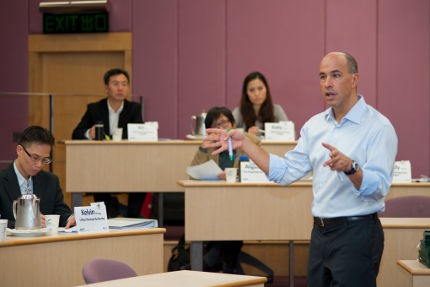
Inside the classroom: Ivey’s case study method
Most MBA students would say that case studies and the discussions that result are one of the most effective ways of learning about business. I was curious to find out how things actually work in a class where students from different backgrounds and industries tackle a specific topic. Would it be like a court room where barristers challenge facts and follow protocol or more like the heated exchanges that can take place in a company board meeting?
Sitting in on a class of the EMBA programme offered by Ivey Business School gave me an insight on how these group discussions work and help executives to learn from one another.
The class was led by Professor Tony Frost who thinks it is important for executives to make decisions quickly. Therefore, the way he organises a group discussion differs somewhat from traditional case study teaching methods. His approach is simple, involving less advance preparation and more thinking on one’s feet.
Instead of asking students to read all kinds of related material beforehand and then dissect it in class, he challenges them to come up with their own opinions about the case in question with little or no background information.

Professor Tony Frost
The quick-fire discussion on any given case lasts about 30 minutes, with everyone expected to contribute and original thinking actively encouraged.
On the day, the main theme of the class was the impact of global economic crisis on corporate strategies. Things kicked off with a lecture on the topic, followed by a series of case studies to analyse and debate.
The first looked at the impact of financial crisis on Cathay Pacific. Professor Frost highlighted a few key considerations on PowerPoint and then gave students about 10 minutes to talk among themselves before presenting their ideas to the class.
Ivey EMBA students are no strangers to such methods. The general impression was that everyone had strong views and was eager to express them, with the discussion bringing out a wide range of opinions. Some executives saw the global financial turndown having a major adverse impact on Cathay, others saw it as an opportunity and springboard for growth. The debate touched on fuel costs, companies cutting travel budgets, and the most profitable routes. Professor Frost acted as facilitator, getting students to express contrasting viewpoints, which made for a vibrant and meaningful discussion.
Feedback and ideas were summarised on a whiteboard before the class moved on to the next case focusing on how the financial crisis is affecting another company in a different industry.
One Ivey student, Peter Dingle, who works for Intel, had already done more than 150 case studies before taking Professor Frost’s class and speaks highly of the method. “It feels like we are being put on the spot and we need to make a decision,” he says. “The discussion format pushes us to draw on relevant skills and knowledge. The exchanges are fast-paced, as they are for executives in real business situations, and that has definitely prepared me to be a better decision maker.”
